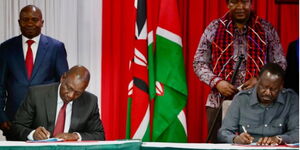The National Treasury has reverted to using Gross Domestic Product (GDP) to calculate the country's debt ceiling.
Notably, Kenya has previously used this method but abandoned it in 2019, preferring to adopt the numerical debt ceiling even as Kenya’s debt passed the Ksh10 trillion mark in June 2023.
In a new law signed by President William Ruto, the new debt ceiling will be set at 55 per cent of GDP.
“This mechanism improves debt transparency since public debt is measured relative to the country’s income and ability to pay,” MPs stated while preparing the now passed Bill.
Kenya’s GDP by the end of 2023 is projected to hit Ksh17.7 trillion meaning that by current estimates, the country has already surpassed the 55 per cent limit.
This means that with the new law, Kenya's debt would be pegged at Ksh9.6 trillion, however, due to applying the numerical debt ceiling formula, the country has overshot this by Ksh500 billion.
Conversely, with the new law, the government is projecting to adhere to the 55 per cent target by 2027.
The five-year grace period is meant to give President William Ruto’s administration time to institute policies and frameworks to tame the ballooning public debt.
Additionally, the government will be allowed to borrow up to 60 per cent of GDP in case of extreme or exceptional economic circumstances.
The new law describes extreme and exceptional circumstances as natural disasters or certain political occurrences.
Last week, during an interview with NBC News, Central Bank Governor Kamau Thugge explained that the debt had surpassed the Ksh10 trillion mark due to the COVID-19 pandemic and war in Ukraine.
The Governor also pointed out that an unprecedented drought in Kenya also led to the agricultural sector contracting leading the government to borrow more to sustain the economy.
Thugge assured the international community that Ruto’s administration had put in place measures to ensure Kenya recovered from global and internal economic shocks.
He projected that the country’s economy was poised to grow by 5 per cent which is higher than the global average and also 2 points higher than projections for economies in Sub-Saharan Africa.












